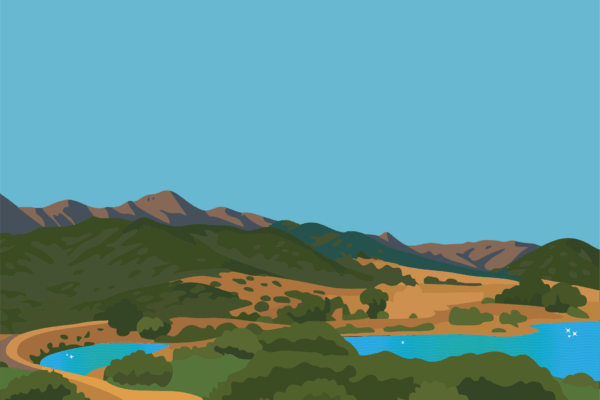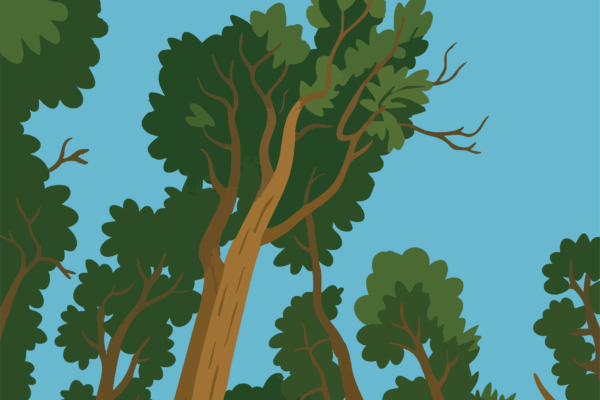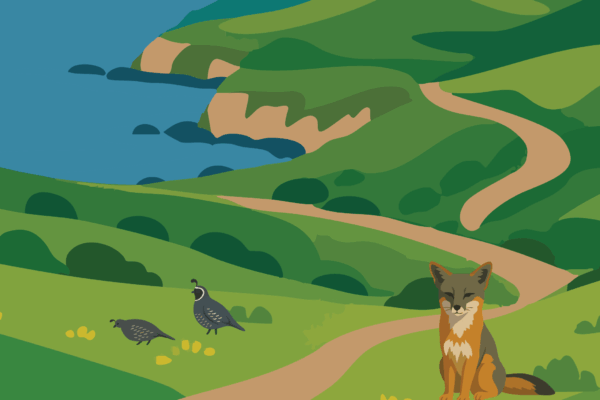Restoring Catalina Island. Protecting its Future.
Operation Protect Catalina Island combines conservation initiatives, habitat restoration and wildfire prevention under one coordinated effort to help establish healthy land and water, bring back native plants and create balance for native species. Together, we can protect the people, livelihoods and native wildlife that depend on one of the most unique places on Earth.
This is Catalina Island’s Survival Plan.
Why This Matters Now
The Threat
Catalina Island faces growing environmental threats. Longer periods of drought, invasive plants and animals, and a changing climate are putting pressure on native habitats, straining freshwater resources and raising the risk of major wildfires. Together, these challenges threaten the Island’s natural balance and the people and native wildlife that depend on it.
🔥The Los Angeles fires in January 2025 demonstrated the vulnerability of Southern California and showed us what’s at stake.
Defending Against Catastrophic Wildfire
The Conservancy works alongside the Los Angeles County Fire Department, Avalon City Fire, Southern California Edison, elected officials, and other agencies to support a safer, more fire-resilient future for Catalina. Conservancy rangers also serve as the Island’s eyes and ears in the wildlands, reporting any fire activity directly to Los Angeles County Fire.
In 2024, our wildfire prevention efforts included:
- Clearing brush from across 700 acres
- Removing flammable invasive plants across more than 150 acres
- Improving miles of roads that double as firebreaks and provide access for fire crews
- Training 11 staff members as wildland firefighters and equipping them with new protective gear
- Lending access to backhoes, bulldozers, water supply tanks and water trucks to support fire crews as needed
These steps make a difference, but they only buy time. Long-term resilience comes from restoring Catalina’s ecosystems so the Island can protect itself naturally.
Community Engagement
Built on Your Feedback
Since January 2024, the Conservancy has gathered community input to shape Operation Protect Catalina Island and address concerns around safety, transparency and reporting.
Restoration Management Plan
As part of Operation Protect Catalina Island, the Conservancy is pursuing approval for island restoration work with the California Department of Fish and Wildlife through California’s Restoration Management Permit (RMP) program. The RMP streamlines conservation work, allowing critical restoration to move forward efficiently and responsibly.
Backed by Research
Global, national and California researchers and have established the science on invasive species and their impacts on island ecosystems. Operation Protect Catalina Island is built on decades of peer-reviewed research, including field studies conducted on Catalina itself by esteemed universities and institutions. This is established science applied to protect our Island’s future.
Research, Findings and Data Sources
Studies on Catalina Island
Deer Impact studies
- Dvorak, T. M., & Catalano, A. E. (2016). Exclusion of introduced deer increases size and seed production success in an island-endemic plant species. Ecology and Evolution, 6(2), 544–551.
- Manuwal, T., & Sweitzer, R. (2007). Browse impacts of introduced mule deer to island scrub oak habitats on Santa Catalina Island, California. Avalon: Catalina Island Conservancy.
- Ramirez, A. R., Pratt, R. B., Jacobsen, A. L., & Davis, S. D. (2012). Exotic deer diminish post-fire resilience of native shrub communities on Santa Catalina Island, southern California. Plant Ecology, 213, 1037–1047.
- Salladay, R. A., & Ramirez, A. R. (2018). Reduced defenses and increased herbivore preference of island chaparral shrubs compared to mainland relatives. Western North American Naturalist, 78(4), 768–776.
- Stapp, P., Hamblen, E., Duncan, C. L., & King, J. L. (2022). Status of the introduced mule deer population on Catalina Island, California, based on annual spotlight counts. Proceedings of the Vertebrate Pest Conference, 30.
Supporting Restoration/Fire Studies
- Jacobsen, A. L., Pratt, R. B., Alleman, D., & Davis, S. D. (2018). Post-fire ecophysiology of endemic chaparral shrub seedlings from Santa Catalina Island, Southern California. Madroño, 65(3), 106–116.
- Knapp, D. A. (2009). Oak ecosystem restoration on Catalina Island (unpublished; cited as ongoing work related to deer as a threat).
- Knapp, D. A. (2010). Changes in oak distribution and density by decade on Santa Catalina Island, 1943.
- Knapp, D. A. (2014). Ecosystem restoration on Santa Catalina Island: A review of potential approaches and the promise of bottom-up invader management. Monographs of the Western North American Naturalist, 7(1), 421–434.
- Minnich, R. A. (1982). Grazing, fire, and vegetation management on Santa Catalina Island. In: Proceedings of the symposium on dynamics and management of Mediterranean-type ecosystems. USDA Forest Service PSW-GTR-058.
Studies on Other Channel Islands
- Cloud, J., & Taylor, R. (2002). Ungulate impacts on Santa Rosa Island vegetation.
- Longcore, T., MacDonald, B., & Wilson, J. P. (2020). Reconstruction of historical topography to estimate erosion and model historical vegetation distribution on San Clemente Island, California. UCLA Institute of the Environment and Sustainability.
- Summers, R., Masukawa, J., & Hartman, B. D. (2018). The influence of slope on vegetation recovery following nonnative grazer removal on Santa Rosa Island, California. Western North American Naturalist, 78(4), 787–798.
- Thomson, J. M., Smith, A. L., & Morrison, S. D. (2022). Santa Rosa Island vegetation recovery after herbivore removal. Biological Invasions.
Additional Research References
- Allombert, S., Stockton, S., & Martin, J.-L. (2005). A natural experiment on the impact of overabundant deer on forest invertebrates. Conservation Biology, 19(6), 1917–1929.
- Ashley, M. V., & Wills, C. (1987). Analysis of mitochondrial DNA polymorphisms among Channel Island deer mice. Evolution, 41(4), 854–863.
- Chollet, S., Bergman, C., Gaston, A. J., & Martin, J.-L. (2014). Long-term consequences of invasive deer on songbird communities: Going from bad to worse? Biological Invasions, 17, 777–790.
- Crystal-Ornelas, R., Brown, J. A., Valentin, R. E., Beardsley, C., & Lockwood, J. L. (2021). Meta-analysis shows that overabundant deer (Cervidae) populations consistently decrease average population abundance and species richness of forest birds. Ornithological Applications, 123.
- Dickens, S. J. M., & Allen, E. B. (2013). Exotic plant invasion alters chaparral ecosystem resistance and resilience pre- and post-wildfire. Biological Invasions, 16, 1119–1130.
- Fellers, G. M., Drost, C. A., & Arnold, B. W. (1988). Terrestrial vertebrates monitoring handbook. National Park Service, Channel Islands National Park. Ventura, CA.
- Fisher, R. N. (2004). Baseline biodiversity survey for Santa Catalina Island: Herpetofauna and ants with remarks on small mammals and others. U.S. Geological Survey Final Report prepared for Catalina Island Conservancy, CA.
- Foster, M. S., & Schiel, D. R. (2010). Loss of predators and the collapse of southern California kelp forests: Alternatives, explanations, and generalizations. Journal of Experimental Marine Biology and Ecology, 59–70.
- Kahl, S., Wood, C. M., Eibl, M., & Klinck, H. (2021). BirdNET: A deep learning solution for avian diversity monitoring. Ecological Informatics, 61, 101236.
- Knapp, D. A. (2005). Rare plants in the Goat Harbor burn area. In Proceedings of the Sixth California Islands Symposium (pp. 205–211). Ventura: Institute for Wildlife Studies and National Park Service.
- Knapp, J. J. (2007). Catalina Island Invasive Plant Management Plan. Unpublished report submitted to the Catalina Island Conservancy, Avalon, California.
- Martin, T. G., Arcese, P., & Scheerder, N. (2011). Browsing down our natural heritage: Deer impacts on vegetation structure and songbird populations across an island archipelago. Biological Conservation, 144(1), 459–469.
- Moriarty, M. E., Vickers, T. W., Clifford, D. L., Garcelon, D. K., Gaffney, P. M., Lee, K. W., King, J. L., Duncan, C. L., & Boyce, W. M. (2015). Ear mite removal in the Santa Catalina Island fox (Urocyon littoralis catalinae): Controlling risk factors for cancer development. PLoS One, 10(12), e0144271.
- Mullin, B. H., Anderson, L. W., DiTomaso, M., Eplee, R. E., & Getsinger, K. D. (2000). Invasive plant species. Issue Paper No. 13, Council for Agricultural Science and Technology, 18 pp.
- Orians, C., & Ward, D. (2010). Evolution of plant defenses in nonindigenous environments. Annual Review of Entomology, 55, 439–459.
- Perlmutter, G. B. (1986). Preliminary studies on the distribution of native mice on Santa Catalina Island, CA. In F. G. Hochberg (Ed.), Third California Islands Symposium: Recent Advances in Research on the California Islands (pp. 429–432). Santa Barbara Museum of Natural History.
- Phillips, G. E., & Cristol, D. A. (2024). Mechanisms of deer (Cervidae) impacts on birds: A comprehensive review. Biological Conservation, 290, 110454.
- Phillips, M. L., & Allen, E. B. (2023). Invasive grass density negatively impacts chaparral seedling establishment. Restoration Ecology, 32(3).
- Powell, J. A. (1994). Biogeography of Lepidoptera on the California Channel Islands. In W. L. Halvorson & G. J. Maender (Eds.), The Fourth California Islands Symposium: Update on the Status of Resources (pp. 449–464). Santa Barbara Museum of Natural History.
- Powell, J. A. (2012). Lepidoptera recorded on Santa Catalina Island.
- Schwemm, C. A., & Coonan, T. J. (2001). Status and ecology of deer mice (Peromyscus maniculatus subsp.) on Anacapa, Santa Barbara, and San Miguel Islands, California: Summary of monitoring 1992–2000. National Park Service, Channel Islands National Park, Ventura, CA.
- Shuford, W. D., & Gardali, T. (Eds.). (2008). California Bird Species of Special Concern. Western Field Ornithologists and California Department of Fish and Game.
- Southwood, T. (1978). Ecological Methods: With Particular Reference to the Study of Insect Populations. New York: Wiley.
- Vickers, T. W., Clifford, D. L., Garcelon, D. K., King, J. L., Duncan, C. L., Gaffney, P. M., & Boyce, W. M. (2015). Pathology and epidemiology of ceruminous gland tumors among endangered Santa Catalina Island foxes (Urocyon littoralis catalinae) in the Channel Islands, USA. PLoS One, 10(11), e0143211.
- Weidlich, E. W., Florido, F. G., Sorrini, T. B., & Brancalion, P. H. (2020). Controlling invasive plant species in ecological restoration: A global review. Journal of Applied Ecology, 57, 1806–1817.
Other References
- APRS Implementation Team. (2000). Alien Plants Ranking System Version 5.1. Jamestown, ND: Northern Prairie Wildlife Research Center.
- California Botanic Garden. (2024). Seed Collection Policy (Amended 31 January 2024). 9 pp.
- Center for Plant Conservation. (2019). CPC Best Plant Conservation Practices to Support Species Survival in the Wild.
- Morrison, S. (2023, October 17). Letter of support for the Catalina Island Conservancy’s Catalina Island Restoration Project.










